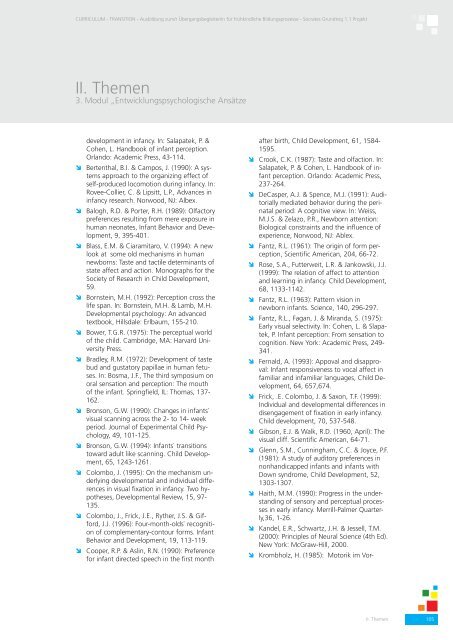Dokumentation Grundtvig 2
Dokumentation Grundtvig 2
Dokumentation Grundtvig 2
Sie wollen auch ein ePaper? Erhöhen Sie die Reichweite Ihrer Titel.
YUMPU macht aus Druck-PDFs automatisch weboptimierte ePaper, die Google liebt.
05-08-2008-II._Themen-3_Modul:<strong>Dokumentation</strong> <strong>Grundtvig</strong> 2 25.08.2008 16:42 Seite 105<br />
CURRICULUM - TRANSITION - Ausbildung zum/r Übergangsbegleiter/in für frühkindliche Bildungsprozesse - Socrates <strong>Grundtvig</strong> 1.1 Projekt<br />
II. Themen<br />
3. Modul „Entwicklungspsychologische Ansätze<br />
development in infancy. In: Salapatek, P. &<br />
Cohen, L. Handbook of infant perception.<br />
Orlando: Academic Press, 43-114.<br />
î Bertenthal, B.I. & Campos, J. (1990): A systems<br />
approach to the organizing effect of<br />
self-produced locomotion during infancy. In:<br />
Rovee-Collier, C. & Lipsitt, L.P., Advances in<br />
infancy research. Norwood, NJ: Albex.<br />
î Balogh, R.D. & Porter, R.H. (1989): Olfactory<br />
preferences resulting from mere exposure in<br />
human neonates, Infant Behavior and Development,<br />
9, 395-401.<br />
î Blass, E.M. & Ciaramitaro, V. (1994): A new<br />
look at some old mechanisms in human<br />
newborns: Taste and tactile determinants of<br />
state affect and action. Monographs for the<br />
Society of Research in Child Development,<br />
59.<br />
î Bornstein, M.H. (1992): Perception cross the<br />
life span. In: Bornstein, M.H. & Lamb, M.H.<br />
Developmental psychology: An advanced<br />
textbook, Hillsdale: Erlbaum, 155-210.<br />
î Bower, T.G.R. (1975): The perceptual world<br />
of the child. Cambridge, MA: Harvard University<br />
Press.<br />
î Bradley, R.M. (1972): Development of taste<br />
bud and gustatory papillae in human fetuses.<br />
In: Bosma, J.F., The third symposium on<br />
oral sensation and perception: The mouth<br />
of the infant. Springfield, IL: Thomas, 137-<br />
162.<br />
î Bronson, G.W. (1990): Changes in infants`<br />
visual scanning across the 2- to 14- week<br />
period. Journal of Experimental Child Psychology,<br />
49, 101-125.<br />
î Bronson, G.W. (1994): Infants` transitions<br />
toward adult like scanning. Child Development,<br />
65, 1243-1261.<br />
î Colombo, J. (1995): On the mechanism underlying<br />
developmental and individual differences<br />
in visual fixation in infancy. Two hypotheses,<br />
Developmental Review, 15, 97-<br />
135.<br />
î Colombo, J., Frick, J.E., Ryther, J.S. & Gifford,<br />
J.J. (1996): Four-month-olds` recognition<br />
of complementary-contour forms. Infant<br />
Behavior and Development, 19, 113-119.<br />
î Cooper, R.P. & Aslin, R.N. (1990): Preference<br />
for infant directed speech in the first month<br />
after birth, Child Development, 61, 1584-<br />
1595.<br />
î Crook, C.K. (1987): Taste and olfaction. In:<br />
Salapatek, P. & Cohen, L. Handbook of infant<br />
perception. Orlando: Academic Press,<br />
237-264.<br />
î DeCasper, A.J. & Spence, M.J. (1991): Auditorially<br />
mediated behavior during the perinatal<br />
period: A cognitive view. In: Weiss,<br />
M.J.S. & Zelazo, P.R., Newborn attention:<br />
Biological constraints and the influence of<br />
experience, Norwood, NJ: Ablex.<br />
î Fantz, R.L. (1961): The origin of form perception,<br />
Scientific American, 204, 66-72.<br />
î Rose, S.A., Futterweit, L.R. & Jankowski, J.J.<br />
(1999): The relation of affect to attention<br />
and learning in infancy. Child Development,<br />
68, 1133-1142.<br />
î Fantz, R.L. (1963): Pattern vision in<br />
newborn infants. Science, 140, 296-297.<br />
î Fantz, R.L., Fagan, J. & Miranda, S. (1975):<br />
Early visual selectivity. In: Cohen, L. & Slapatek,<br />
P. Infant perception: From sensation to<br />
cognition. New York: Academic Press, 249-<br />
341.<br />
î Fernald, A. (1993): Appoval and disapproval:<br />
Infant responsiveness to vocal affect in<br />
familiar and infamiliar languages, Child Development,<br />
64, 657,674.<br />
î Frick, .E. Colombo, J. & Saxon, T.F. (1999):<br />
Individual and developmental differences in<br />
disengagement of fixation in early infancy.<br />
Child development, 70, 537-548.<br />
î Gibson, E.J. & Walk, R.D. (1960, April): The<br />
visual cliff. Scientific American, 64-71.<br />
î Glenn, S.M., Cunningham, C.C. & Joyce, P.F.<br />
(1981): A study of auditory preferences in<br />
nonhandicapped infants and infants with<br />
Down syndrome, Child Development, 52,<br />
1303-1307.<br />
î Haith, M.M. (1990): Progress in the understanding<br />
of sensory and perceptual processes<br />
in early infancy. Merrill-Palmer Quarterly,36,<br />
1-26.<br />
î Kandel, E.R., Schwartz, J.H. & Jessell, T.M.<br />
(2000): Principles of Neural Science (4th Ed).<br />
New York: McGraw-Hill, 2000.<br />
î Krombholz, H. (1985): Motorik im Vor-<br />
II. Themen 105











